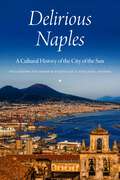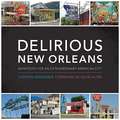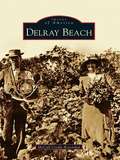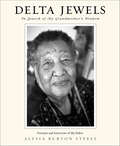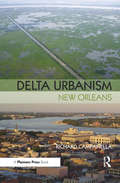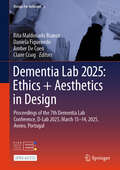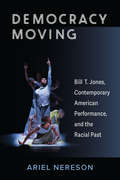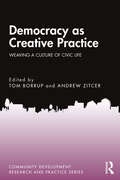- Table View
- List View
Delirio americano: Una historia cultural y política de América Latina
by Carlos GranésDisfruten con la fantasía de los creadores latinoamericanos y observen las nefastas consecuencias del ensueño de los políticos. Y cómo a veces ambos delirios fueron de la mano. Carlos Granés, uno de los pensadores más sólidos y originales de la actualidad, recompone con gran pulso narrativo el inmenso, intrincado y exuberante puzle del largo siglo XX en América Latina. Por primera vez, los lectores pueden recorrer en un mismo relato las etapas, fuerzas y acontecimientos de una historia tradicionalmente contada de manera fragmentaria y profundamente marcada por las complejas relaciones entre cultura y política. El ensayo traza conexiones sorprendentes, muestra reveladoras contradicciones y retrata a figuras como José Martí, César Vallejo, Nahui Olín, Juan Domingo Perón, García Márquez, Doris Salcedo o Caetano Veloso. Desde las primeras reivindicaciones de una América Latina con identidad propia por parte de poetas y ensayistas, el surgimiento del comunismo y el fascismo latinoamericano y la irrupción del populismo hasta la resaca del boom, las nuevas tensiones entre lo local y lo global y la muerte de Fidel Castro en 2016, el libro rastrea el papel de las ideas y las artes en la invención de América Latina y en la construcción de las identidades nacionales durante las dictaduras y revoluciones. Granés da cuenta con brillantez de la influencia del surrealismo, cuyo impacto decisivo fue también político, pues dio lugar a una alternativa individualista, libertaria e imaginativa a las ideologías totalitarias y al populismo que derivaría en la izquierda heterodoxa y en el liberalismo. Delirio americano es un maravilloso fresco, admirablemente narrado, que amplía nuestra mirada sobre un continente cuya historia y destino afectan a las prácticas políticas y culturales de todo Occidente. La crítica ha dicho... «Carlos Granés es en mi opinión uno de los mejores ensayistas de nuestra lengua. Sus libros están escritos en una prosa precisa y flexible, prodigan ideas frescas y son capaces de abrir perspectivas nuevas sobre viejos problemas.» JAVIER CERCAS «Granés es uno de los mejores ensayistas actuales, un escritor brillante y perspicaz».El Confidencial «No creo que nadie haya trazado un fresco tan completo, animado y lúcido sobre todas las vanguardias artísticas del siglo XX. Lo he leído con la felicidad y la excitación con que leo las mejores novelas».Mario Vargas Llosa, sobre El puño invisible «Granés vuelve a dar en el clavo con un ensayo capaz de captar la atención del lector sobre un tema de actualidad y enorme alcance».Forbes, sobre Salvajes de una nueva época «Ameno y riguroso ensayo sobre la liaison de la cultura, el capitalismo y la política».ABC, sobre Salvajes de una nueva época «La política se vuelve vocinglera y el capitalismo vira a lo correcto. Este ensayo pone en limpio lo que parece inconexo».El Mundo, sobre Salvajes de una nueva época
Delirious Naples: A Cultural History of the City of the Sun
by Pellegrino D’Acierno and Stanislao G. PuglieseThis book is addressed to “lovers of paradoxes” and we have done our utmost to assemble a stellar cast of Neapolitan and American scholars, intellectuals, and artists/writers who are strong and open-minded enough to wrestle with and illuminate the paradoxes through which Naples presents itself. Naples is a mysterious metropolis. Difficult to understand, it is an enigma to outsiders, and also to the Neapolitans themselves. Its very impenetrableness is what makes it so deliriously and irresistibly attractive. The essays attempt to give some hints to the answer of the enigma, without parsing it into neat scholastic formulas. In doing this, the book will be an important means of opening Naples to students, scholars and members of the community at large who are engaged in “identity-work.” A primary goal has been to establish a dialogue with leading Neapolitan intellectuals and artists, and, ultimately, ensure that the “deliriously Neapolitan” dance continues.
Delirious New Orleans: Manifesto for an Extraordinary American City
by Stephen VerderberFrom iconic neighborhoods such as the French Quarter and the Garden District to more economically modest but no less culturally vibrant areas, architecture is a key element that makes New Orleans an extraordinary American city. Delirious New Orleans began as a documentary project to capture the idiosyncratic vernacular architecture and artifacts-vintage mom-and-pop businesses, roadside motels, live music clubs, neon signs, wall murals, fast-food joints, and so on-that helped give the city's various neighborhoods their unique character. But because so many of these places and artifacts were devastated by Hurricane Katrina, Delirious New Orleans has become both a historical record of what existed in the past and a blueprint for what must be rebuilt and restored to retain the city's unique multicultural landscape. Stephen Verderber starts with the premise that New Orleans's often-overlooked neighborhoods imbue the city with deep authenticity as a place. He opens Delirious New Orleans with a photo-essay that vividly presents this vernacular architecture and its artifacts, both before Katrina and in its immediate aftermath. In the following sections of the book, which are also heavily illustrated, Verderber takes us on a tour of the city's commercial vernacular architecture, as well as the expressive folk architecture of its African American neighborhoods. He discusses how the built environment was profoundly shaped by New Orleans's history of race and class inequities and political maneuvering, along with its peculiar, below-sea-level geography. Verderber also considers the aftermath of Katrina and the armada of faceless FEMA trailers that have, at least temporarily and by default, transformed this urban landscape.
Delirious New York: A Retroactive Manifesto for Manhattan
by Rem KoolhaasSince its original publication in 1978, Delirious New York has attained mythic status. Back in print in a newly designed edition, this influential cultural, architectural, and social history of New York is even more popular, selling out its first printing on publication. Rem Koolhaas's celebration and analysis of New York depicts the city as a metaphor for the incredible variety of human behavior. At the end of the nineteenth century, population, information, and technology explosions made Manhattan a laboratory for the invention and testing of a metropolitan lifestyle -- "the culture of congestion" -- and its architecture."Manhattan," he writes, "is the 20th century's Rosetta Stone . . . occupied by architectural mutations (Central Park, the Skyscraper), utopian fragments (Rockefeller Center, the U.N. Building), and irrational phenomena (Radio City Music Hall)." Koolhaas interprets and reinterprets the dynamic relationship between architecture and culture in a number of telling episodes of New York's history, including the imposition of the Manhattan grid, the creation of Coney Island, and the development of the skyscraper. Delirious New York is also packed with intriguing and fun facts and illustrated with witty watercolors and quirky archival drawings, photographs, postcards, and maps. The spirit of this visionary investigation of Manhattan equals the energy of the city itself.
Delivering New Homes: Planning, Processes and Providers
by Nick Gallent Sarah CarmonaThis book examines the processes and relationships that underpin the delivery of new homes across the United Kingdom, focussing primarily on the land use planning system in England, the way that housing providers engage with that system, and how the processes of engagement are changing or might change in the future. Planning, market and social house building - the three key processes - are first dissected and explored individually, then brought together to study the key areas of interaction between planning and the providers of social and market housing by way of the range of tensions that have consistently dogged those interactions. Extensive illustrative case study material provides a platform to the consideration of developing more integrated, realistic and proactive approaches to planning.Proposing evolutionary, and sometimes radical proposals for change, Delivering New Homes makes a bold contribution to finding a better way of delivering the new homes that the nation increasingly needs.
Delivering on the Climate Emergency: Towards a Net Zero Carbon Built Environment
by Philip Oldfield Deo Prasad Aysu Kuru Lan Ding Malay Dave Caroline Noller Baojie HeThis book focuses on the transition towards net-zero carbon built environments to deliver on the climate emergency. It provides an evidence-based roadmap and proposes guidelines to achieving targets covering emerging technologies, materials, innovative design, regulations and policies.
Delmar's Handbook of Flowers, Foliage, and Creative Design
by Norah T. HunterThe Handbook of Flowers, Foliage, and Creative Design is a practical guide for anyone who enjoys the art of floral design. This book provides easy access to basic information as well as step-by-step floral arrangement instructions, a full-color flower and foliage identification section, and a glossary containing technical terminology used within the industry.
Delphi (Images of America)
by Bonnie J. Maxwell Delphi Preservation Society, Inc. Anita L. WerlingDelphi is nestled in the picturesque valley formed by the Wabash River and Deer Creek. Named for the Grecian city with its famed oracle, Delphi was envisioned by early residents as a center of culture for the surrounding area. Three courthouses have graced the central square in Delphi--the "seat of justice" in Carroll County since platted in 1828 by Gen. Samuel Milroy. When the Wabash and Erie Canal cut through the area in the 1840s, Delphi became a center for industry and commerce. Handsome three-story brick buildings appeared in the 1850s and surrounded the square by the 1880s. Area residents traveled to Delphi for trade, business, and entertainment. Delphi's opera houses drew traveling acts from Chicago, Indianapolis, Cincinnati, and other cultural centers. Visitors today enjoy the architectural gems downtown and in nearby residential districts plus six parks with miles of groomed hiking and biking trails. The canal era is alive in Delphi at the Wabash and Erie Canal Interpretive Center where a replica boat takes visitors on a restored section of the historic waterway.
Delray Beach (Images of America)
by Mccall Credle-RosenthalDelray Beach lies on Florida's Atlantic coast, nestled between a sea grape-filled beach to the east and rich farmland to the west. Throughout its prosperous history, this "Village by the Sea," as it is often called, has maintained its mystical, quaint charm. The numerous stories of Delray Beach, kept alive through many of the town's elders, are rich depictions of the American experience. The importance of the past continues to reveal itself in the stories and images of the courageous pioneers who came from Michigan, the Bahamas, and nearby Southern states in the late 1800s.Early pioneers were attracted to Delray Beach for many of the same reasons that bring people there today. The history of Delray Beach is intrinsically linked to the community support of and appreciation for agriculture, art, and architecture. The area is known for fertile soil, diverse crops, and the large colony of artists that call their bungalows and cottages along the Delray beaches home. Thousands of visitors annually flock to attend the numerous festivals held in the city's historic downtown streets. In both 1993 and 2001, Delray Beach received the prestigious "All America City" award from the National Civic League.
Delray Beach (Postcard History Series)
by Janet Devries Dorothy PattersonTravel the roads and waterways of Delray Beach history through lovingly collected postcards. In the 1890s, a diverse group of settlers began gathering on the southeast coast of Florida to build a new community. These pioneers sought the freedom, adventure, and economic opportunity provided by the new Florida East Coast Railway. Delray's population was distinctive for its respect for education, early interest in the arts, love of sports, religious faith, and bonds of community. By the 1920s, the farming-fishing settlement had blossomed into a sparkling resort town with a thriving winter colony. This unfolding story of Delray Beach and the surrounding vicinity is presented from the Delray Beach Historical Society Archives and private collections.
Delta County (Images of America)
by Sylvia Wood Judy Falls Friends of Delta County Public LibraryDuring the frenetic days of Reconstruction, Delta County claimed land between two branches of the Sulphur River, from Lamar and Hopkins Counties, and named itself after its shape and the third letter of the Greek alphabet. From its early days, Delta County became home to prosperous farmers who relocated from the South and who brought with them their knowledge of growing cotton as well as their traditions and cultures. At its heyday in the 1920s, the county boasted the densest rural population in the state. These pioneers believed strongly in education, and more than 40 schools dotted the county at one time, with many graduates of these rural schools becoming doctors, engineers, teachers, politicians, ministers, authors, musicians, lawyers, coaches, scientists, and athletes--as well as one All-American. For those who remained, those who returned, and those who chose this quiet corner of Northeast Texas, Delta County is home, with all the sweet and poignant implications of that word.
Delta Jewels: In Search of My Grandmother's Wisdom
by Alysia Burton SteeleInspired by memories of her beloved grandmother, photographer and author Alysia Burton Steele -- picture editor on a Pulitzer Prize-winning team -- combines heart-wrenching narrative with poignant photographs of more than 50 female church elders in the Mississippi Delta. These ordinary women lived extraordinary lives under the harshest conditions of the Jim Crow era and during the courageous changes of the Civil Rights Movement. With the help of local pastors, Steele recorded these living witnesses to history and folk ways, and shares the significance of being a Black woman -- child, daughter, sister, wife, mother, and grandmother in Mississippi -- a Jewel of the Delta. From the stand Mrs. Tennie Self took for her marriage to be acknowledged in the phone book, to the life-threatening sacrifice required to vote for the first time, these 50 inspiring portraits are the faces of love and triumph that will teach readers faith and courage in difficult times.
Delta Urbanism: New Orleans
by Richard CampanellaThis volume of APA's Delta Urbanism series traces the development of New Orleans from precolonial times to post-Katrina realities, in the context of the deltaic plain on which it lies. The book describes the underlying physical terrain and covers the various transformations humans have made to it: site selection, settlement, urbanization, population, expansion, drainage, protection, exploitation, devastation, and recovery. What New Orleans has experienced foretells what similar cities will be tackling in years to come.
Delta Urbanism: The Netherlands
by Han Meyer Steffen Nijhuis Inge BobbinkDelta Urbanism is a major new initiative that explores the growth, development, and management of deltaic cities and regions, with the aim of balancing various goals in a sustainable manner: urbanization, port commerce, industrial development, flood defense, public safety, ecological balance, tourism, and recreation. This book is a detailed history and overview of how one low-lying country has developed the policies, tools, technology, planning, public outreach, and international cooperation needed to save their populated deltas.
Deltaville
by Larry S. ChowningIn the early 20th century, the communities previously recognized as Sandy Bottom, Enoch, Stingray Point, Ruark, Amburg, Stove Point, Horse Shoe Bend, Pace's Neck, and Grinels became part of what is known today as Deltaville. Strategically located between two major rivers and the Chesapeake Bay, Deltaville has been center stage to many events that have shaped the nation. During the Revolutionary War and the War of 1812, friend and foe visited its shores. Six decades later, both Union and Confederate blood was spilled on its ground. Throughout the early 20th century, Deltaville's shores played a large part in local industry. Common occupations included wooden boatbuilding, freighting, oystering, crabbing, and fishing. By the end of the century, the community had grown into a waterfront resort and served as a playground for recreational boaters and visitors.
Dementia Lab 2021: Proceedings of the 5th Dementia Lab Conference, D-Lab 2021, January 18–28, 2021 (Design For Inclusion #2)
by Rens Brankaert Caylee Raber Maarten Houben Paulina Malcolm Jon HannanThis book gathers revised and selected contributions to the 5th Dementia Lab Conference, D-Lab 2021, organized online on January 18-28, 2021, from the Emily Carr University of Art + Design, Vancouver, Canada. It describes original strategies in which design or creative methods have been shown to uncover, support and enhance the abilities of people living with dementia. Papers report on new ideas and findings relating to three main themes: engagement, empowerment and identity. They cover: ethics of inclusion and solutions for shifting the culture of care to be focused on both personal independence and reconnecting with the community; new ways of designing with people living with dementia; strategies for breaking negative stereotypes and preconceived opinions; and approaches to retaining personhood and dignity. Offering a timely source of information on new design and creative methods to a broad community of industrial, communication, interactive and inclusive designers, this book is also meant to address and inspire various stakeholders and organizations in dementia care.
Dementia Lab 2022: Proceedings of the 6th Dementia Lab Conference, D-Lab 2022, September 20–22, 2022, Leuven, Belgium (Design For Inclusion #3)
by Rens Brankaert Maarten Houben Niels Hendriks Andrea Wilkinson Kellie MorrisseyThis book gathers the revised and selected contributions to the 6th Dementia Lab Conference, D-Lab 2022, held on September 20-22, 2022, in Leuven. It describes original and innovative research on how design can contribute to the quality of life of people with dementia, their loved ones, and caregivers. The papers highlight the value of participation within design, analyzing it at three levels: personal, product, and organizational. The presented ideas and findings address ‘The Residue of Design’ and go beyond the initial impact of the design itself by looking at what benefits design research brings for people with dementia. The papers cover topics such as the development of creative design methods to foster participation and engagement from people with dementia, evaluation studies or critical reflections that reveal the impact of products and the built environment in dementia care, and raising awareness and countering stigma in societal views on dementia.
Dementia Lab 2025: Proceedings of the 7th Dementia Lab Conference, D-Lab 2025, March 13–14, 2025, Aveiro, Portugal (Design For Inclusion #5)
by Claire Craig Rita Maldonado Branco Daniela Figueiredo Amber De CoenThis is an open access book. It gathers revised and selected contributions to the 7th Dementia Lab Conference, D-Lab 2025, held on March 13–14, 2025, in Aveiro, Portugal, reporting on innovative research aimed at improving the lives of people with dementia, their loved ones, and their caregivers. This edition addresses the theme of ethics + aesthetics in design. Ethics emphasize justice, advocate for inclusive, person-centred practices, and challenge societal stigmas. Aesthetics, beyond beauty, focus on sensory and emotional engagement, which becomes increasingly significant as dementia progresses. Together, these principles guide innovative design approaches that enhance care, identity, and connection. Being organized into three themes, Designing with People with Dementia, Including Design in Dementia Care, and Design within Cultures of Care, this collection highlights research on participation, technology, and the cultural dimensions of care. It also demonstrates the key role of design in creating products and environments that embrace aesthetic value and is expected to challenge stigmas and unrealistic assumptions about people living with dementia
Dementia, Narrative and Performance: Staging Reality, Reimagining Identities
by Janet GibsonFocusing mainly on case studies from Australia and the United States of America, this book considers how people with dementia represent themselves and are represented in ‘theatre of the real’ productions and care home interventions, assessing the extent to which the ‘right kind’ of dementia story is being affirmed or challenged. It argues that this type of story — one of tragedy, loss of personhood, biomedical deficit, and socio-economic ‘crisis — produces dementia and the people living with it, as much as biology does. It proposes two novel ideas. One is that the ‘gaze’ of theatre and performance offers a reframing of some of the behaviours and actions of people with dementia, through which deficit views can be changed to ones of possibility. The other is that, conversely, dementia offers productive perspectives on ’theatre of the real’. Scanning contemporary critical studies about and practices of ‘theatre of the real’ performances and applied theatre interventions, the book probes what it means when certain ‘theatre of the real’ practices (specifically verbatim and autobiographical) interact with storytellers considered, culturally, to be ‘unreliable narrators’. It also explores whether autobiographical theatre is useful in reinforcing a sense of ‘self’ for those deemed no longer to have one. With a focus on the relationship between stories and selves, the book investigates how selves might be rethought so that they are not contingent on the production of lucid self-narratives, consistent language, and truthful memories.
Democracy Moving: Bill T. Jones, Contemporary American Performance, and the Racial Past (Theater: Theory/Text/Performance)
by Ariel NeresonOn the 200th anniversary of Abraham Lincoln’s birth, renowned choreographer and director Bill T. Jones developed three tributes: Serenade/The Proposition, 100 Migrations, and Fondly Do We Hope . . . Fervently Do We Pray. These widely acclaimed dance works incorporated video and audio text from Lincoln’s writings as they examined key moments in his life and his enduring legacy. Democracy Moving explores how these works provided both an occasion and a method by which democracy and history might be reconceived through movement, positioning dance as a form of both history and historiography. The project addresses how different communities choose to commemorate historical figures, events, and places through art—whether performance, oratory, song, statuary, or portraiture—and in particular, Black US American counter-memorial practices that address histories of slavery. Advancing the theory of oscillation as Black aesthetic praxis, author Ariel Nereson celebrates Bill T. Jones as a public intellectual whose practice has contributed to the project of understanding America’s relationship to its troubled past. The book features materials from Bill T. Jones/Arnie Zane Company’s largely unexplored archive, interviews with artists, and photos that document this critical stage of Jones’s career as it explores how aesthetics, as ideas in action, can imagine more just and equitable social formations.
Democracy Moving: Bill T. Jones, Contemporary American Performance, and the Racial Past (Theater: Theory/Text/Performance)
by Ariel NeresonOn the 200th anniversary of Abraham Lincoln’s birth, renowned choreographer and director Bill T. Jones developed three tributes: Serenade/The Proposition, 100 Migrations, and Fondly Do We Hope . . . Fervently Do We Pray. These widely acclaimed dance works incorporated video and audio text from Lincoln’s writings as they examined key moments in his life and his enduring legacy. Democracy Moving explores how these works provided both an occasion and a method by which democracy and history might be reconceived through movement, positioning dance as a form of both history and historiography. The project addresses how different communities choose to commemorate historical figures, events, and places through art—whether performance, oratory, song, statuary, or portraiture—and in particular, Black US American counter-memorial practices that address histories of slavery. Advancing the theory of oscillation as Black aesthetic praxis, author Ariel Nereson celebrates Bill T. Jones as a public intellectual whose practice has contributed to the project of understanding America’s relationship to its troubled past. The book features materials from Bill T. Jones/Arnie Zane Company’s largely unexplored archive, interviews with artists, and photos that document this critical stage of Jones’s career as it explores how aesthetics, as ideas in action, can imagine more just and equitable social formations.
Democracy as Creative Practice: Weaving a Culture of Civic Life (ISSN)
by Tom Borrup Andrew ZitcerDemocracy as Creative Practice: Weaving a Culture of Civic Life offers arts-based solutions to the threats to democracies around the world, practices that can foster more just and equitable societies. Chapter authors are artists, activists, curators, and teachers applying creative and cultural practices in deliberate efforts to build democratic ways of working and interacting in their communities in a range of countries including the United States, Australia, Portugal, Nepal, the United Kingdom, and Canada. The book demonstrates how creativity is integrated in place-based actions, aesthetic strategies, learning environments, and civic processes. As long-time champions and observers of community-based creative and cultural practices, editors Tom Borrup and Andrew Zitcer elucidate work that not only responds to sociopolitical conditions but advances practice. They call on artists, funders, cultural organizations, community groups, educational institutions, government, and others to engage in and support this work that fosters a culture of democracy.This book is intended for undergraduate and graduate students in the humanities and social sciences, activists, funders, and artists who seek to understand and effect change on local and global scales to preserve, extend, and improve practices of democracy.
Democracy's Body: Judson Dance Theatre, 1962–1964
by Sally BanesDemocracy's Body offers a lively, detailed account of the beginnings of the Judson Dance Theater--a popular center of dance experimentation in New York's Greenwich Village--and its place in the larger history of the avant-garde art scene of the 1960s. JDT started when Robert Dunn, a student of John Cage, offered a dance composition class in Merce Cunningham's studio. The performers--many of whom included some of the most prominent figures in the arts in the early sisties--found a welcome performance home in the Judson Memorial Church in the Village. Sally Banes's account draws on interviews, letters, diaries, films, and reconstructions of dances to paint a portrait of the rich culture of Judson, which was the seedbed for postmodern dance and the first avant-garde movement in dance theater since the modern dance of the 1930s and 1940s. Originally published in 1983, this edition brings back into print a highly regarded work of dance history.
Democratic Art: The New Deal's Influence on American Culture
by Sharon Ann MusherThroughout the Great Recession American artists and public art endowments have had to fight for government support to keep themselves afloat. It wasn't always this way. At its height in 1935, the New Deal devoted $27 million--roughly $461 million today--to supporting tens of thousands of needy artists, who used that support to create more than 100,000 works. Why did the government become so involved with these artists, and why weren't these projects considered a frivolous waste of funds, as surely many would be today? In Democratic Art, Sharon Musher explores these questions and uses them as a springboard for an examination of the role art can and should play in contemporary society. Drawing on close readings of government-funded architecture, murals, plays, writing, and photographs, Democratic Art examines the New Deal's diverse cultural initiatives and outlines five perspectives on art that were prominent at the time: art as grandeur, enrichment, weapon, experience, and subversion. Musher argues that those engaged in New Deal art were part of an explicitly cultural agenda that sought not just to create art but to democratize and Americanize it as well. By tracing a range of aesthetic visions that flourished during the 1930s, this highly original book outlines the successes, shortcomings, and lessons of the golden age of government funding for the arts.
Demographic Angst: Cultural Narratives and American Films of the 1950s
by Alan NadelProlific literature, both popular and scholarly, depicts America in the period of the High Cold War as being obsessed with normality, implicitly figuring the postwar period as a return to the way of life that had been put on hold, first by the Great Depression and then by Pearl Harbor. Demographic Angst argues that mandated normativity—as a political agenda and a social ethic—precluded explicit expression of the anxiety produced by America’s radically reconfigured postwar population. Alan Nadel explores influential non-fiction books, magazine articles, and public documents in conjunction with films such as Singin’ in the Rain, On the Waterfront, Sunset Boulevard, and Sayonara, to examine how these films worked through fresh anxieties that emerged during the 1950s.

